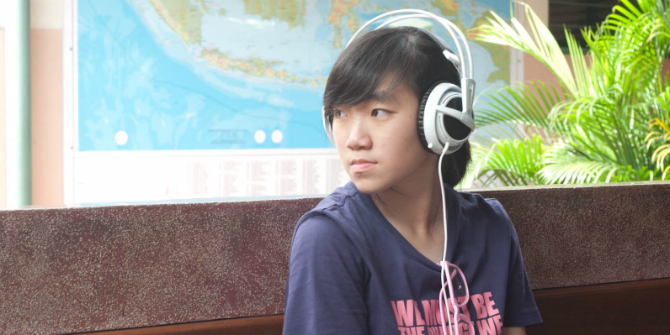 Following a special workshop¹ convened by the Media Policy Project on ‘Families and “screen-time”: challenges of media self-regulation’ and the publication of a new policy brief about families and “screen time”, authored by Alicia Blum-Ross and Sonia Livingstone, Madeleine de Cock Buning reflects on proposals by ERGA to develop Europe-wide categorisations for potentially harmful content, in tandem with national age classifications. Madeleine is the Chair of the European Regulators Group for Audiovisual Media Services (ERGA), President of the Dutch Media Authority and Professor of Media, Communication & Copyright Law at Utrecht University in the Netherlands. [Header image credit: A. Wells, CC BY 2.0]
Following a special workshop¹ convened by the Media Policy Project on ‘Families and “screen-time”: challenges of media self-regulation’ and the publication of a new policy brief about families and “screen time”, authored by Alicia Blum-Ross and Sonia Livingstone, Madeleine de Cock Buning reflects on proposals by ERGA to develop Europe-wide categorisations for potentially harmful content, in tandem with national age classifications. Madeleine is the Chair of the European Regulators Group for Audiovisual Media Services (ERGA), President of the Dutch Media Authority and Professor of Media, Communication & Copyright Law at Utrecht University in the Netherlands. [Header image credit: A. Wells, CC BY 2.0]
Media regulators in Europe receive many complaints from parents who are increasingly worried about the easy access their children have to potentially harmful audiovisual content (such as graphic violence or pornography), particularly online. ERGA, a group of representatives from European regulators who work closely with the European Commission in an advisory role, have worked extensively on some of the issues relating to the protection of minors. In this post, I outline some of the main findings of this report.
Why is current regulation no longer providing effective protection?
In their study, ERGA identified several key factors which are preventing adequate protection of minors in the face of rapid technological changes and developing trends in consumer behaviour:
- The world has changed and audiovisual content is widely available. Studies, such as this one in the UK, demonstrate that technology and consumption patterns have changed, yet the regulation of audiovisual content is still focused on traditional broadcast television. Young people now engage increasingly with content online, be it via Netflix, YouTube, Facebook and other social media networks, which is not regulated in terms of watersheds and often does not have age classifications to inform viewers of the suitability of content for different audiences.
- Whilst tools such as content blockers and filters do exist to protect minors from harmful content, the application of these tools differs greatly depending on the device and platform used. This is especially the case when watching audio-visual content online and particularly with user-generated content.
- The distinction between linear and non-linear services has resulted in regulation that no longer meets audience expectations in terms of the protection of minors. The feedback provided during the recent public consultation for the REFIT evaluation of the AVMS Directive demonstrated that many stakeholders, representing both the traditional and the new media service providers as well as consumer and audience associations, believe that all platforms distributing audiovisual material including video sharing websites should offer the same level of protection.
- Not all content is classified for age appropriateness and current classification systems are not yet aligned across Europe. As a result, neither parents nor minors are fully informed in advance about the suitability of content they access. It also creates obstacles to developing effective mechanisms (like filters and blockers) for parents to control what content their children are able to view.
As a consequence, there is still a lot of content that is inappropriate and potentially harmful to younger viewers that is readily available to all. The current policy on the protection of minors and audio-visual content, which does not address these issues relating to video-sharing platforms, has shown itself to be inadequate.
How should the protection of minors evolve in the future?
The ERGA report on the protection of minors outlines how, in the expert view of independent European audiovisual regulators, the protection of minors should evolve in the future EU legislative framework. ERGA proposes the establishment of a system that is able to protect minors in a converged world, by setting out clear minimum standards and leaving room for flexibility by member states in the way that such standards are implemented. This should ensure that new legislation is both future proof and sensitive to the cultural differences within the EU. ERGA is of the opinion that any audiovisual mass media content, which includes films in the cinema and on DVD, as well as video on demand and other online distribution, should be taken into account in the revision of the current legislative framework.
More specifically, ERGA finds that the current distinction between linear and on-demand audiovisual content in protection levels made in the AVMS Directive are no longer justified, especially in light of recent trends suggesting that younger viewers are increasingly viewing content online. Technical tools that are efficient, easy to use and affordable should be developed and distributed to implement information and protection across all services. So regardless of whether a video will be watched on a website, via an app on a mobile device or a smart TV, adequate protection should be ensured on all platforms and all devices. Parents should have at their disposal the widest set of tools to protect their children, and ERGA believes that a harmonised age classification system for all audiovisual mass media content is essential in this respect.
We have to keep our framework future-proof, so the key questions we have to answer are:
- How can we encourage industry to implement adequate systems to protect minors from any audiovisual mass media content that is potentially harmful?
- What should the role be of European legislation and of European audiovisual regulators in this respect?
Industry: get involved!
To start with the last question: firstly, ERGA believes that in order to ensure protection of minors, there is a need for common technical interfaces across Europe. ERGA would like to encourage more collaboration and interaction between the most relevant stakeholders to enable the development of such interfaces. By stakeholders, we mean industry in its broadest sense, representing the whole media value chain, such as: platform operators, access and navigation tool providers and device manufacturers. Due to digital convergence the platform used for distribution and the device used for reception of the service can differ greatly, which means a broad and engaged involvement of stakeholders is crucial in achieving harmonisation and standardisation. Stakeholders also include the public sector, particularly public administrations and regulators at the national and European level. Last but certainly not least, viewers must not be overlooked. The involvement of the citizens, both in their roles as consumers and as parents, is vital to allow the development of effective protection tools and information and age classification systems for audiovisual content. Whilst industry has without a doubt developed some interesting and valuable initiatives, the fragmentation and lack of standardisation of protection tools prevent many parents and consumers from using them. Media literacy could therefore also provide added value by empowering consumers and increasing their awareness of existing tools.
The role of legislation and regulation
As far as the second question is concerned, perhaps not enough efforts have been made to convince industry of the potential added value and full (commercial) potential of universal, user-friendly, affordable and efficient protection tools accompanying their services. We argue that it is in their best interest to seriously take up the development of these systems since we can safely assume that customers will be highly appreciative of adequate protection tools, especially ones that are easy to use. And maybe the audience should make its demands more explicit. In some countries such as the UK, media consumers have a stronger and more visible representation than in other European countries, such as the Netherlands. Also here ERGA can play an important role in encouraging more interaction between the major stakeholders, for instance by mapping best practice models and organising workshops and similar events to initiate more public debates. And hopefully we can also encourage the establishment of financial incentives at the EU level in order to commission the necessary research and to implement universal protection tools and information systems.
NOTES
¹ A summary of a related event on families and ‘screen time’ has been published by the Media Policy Project and Parenting for a Digital Future, and is available to read here.
This text was originally published on the Media Policy Project blog and has been re-posted with permission.






